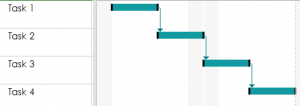
As a project manager, your success hinges on wielding the right methodology for the job. Agile, with its nimble, iterative flair, and Waterfall, with its structured, process-based workflow, are the two titans clashing for supremacy. But which one reigns supreme?
Choosing between Agile and Waterfall is not a minor decision. It’s like picking your weapon before charging into war. It’s a critical piece of the puzzle that could make or break projects.
But here’s the rub: it depends. Projects come in so many shapes and sizes, in different industries with different owners, that it’s impossible to group every single one together as a homogeneous group. Agile evangelists used to claim that it was the new and improved project management methodology and that waterfall was outdated and obsolete, but we have since realized that is not the case. They coexist together, and project managers have to know which method is right for their project.
That said, let’s dive in, starting with a quick rundown of each.
Waterfall
I’ve always had a problem with the word “waterfall.” In my background in engineering and construction, there are very few Gantt charts that actually look like a waterfall. Projects that consist of a bunch of tasks taking place one after the other in perfect sequence are probably not complex enough to need project management methodologies, and the word Waterfall struck me as a way for Agile evangelists to claim existing project management methods are outdated by downplaying their relevance.
Waterfall is the original project management system, a methodical approach where you plan something out and then do it. Each phase—requirements, design, implementation, testing, deployment—flows into the next like a well-oiled engine. It’s predictable, disciplined, and thrives when the project’s scope is clear. Imagine you’re building a bridge: the blueprints are set, the materials are ordered, and every bolt is accounted for before construction begins (well, maybe).
Waterfall shines when the work is well understood because it minimizes surprises. But what happens when the client wants to add a pedestrian lane halfway through? That’s where Waterfall’s rigidity can stall the race.
Agile
Agile, on the other hand, is the scrappy, adaptive newcomer. It breaks projects into sprints—short, iterative cycles where teams deliver small, functional chunks of the product. Feedback is constant, and changes are embraced, not feared. Picture a racecar zipping through a twisting track, adjusting to every curve in real-time. Agile excels when the end goal is fuzzy or likely to evolve, like developing a cutting-edge app where user needs shift as trends emerge.
So, how do you know which methodology to fuel your project with?
Consider the Likelihood of Project Changes
 It’s somewhat paradoxical that construction, manufacturing, and resource projects, where the work is quite well known and therefore ideal for Waterfall, tend to have many project changes. But these changes tend to arise from the complexity of their external circumstances rather than a failure in planning.
It’s somewhat paradoxical that construction, manufacturing, and resource projects, where the work is quite well known and therefore ideal for Waterfall, tend to have many project changes. But these changes tend to arise from the complexity of their external circumstances rather than a failure in planning.
Generally speaking, Waterfall is your go-to for well-understood projects where financial stakeholders can and should expect a reliable estimate prior to performing the work. Think construction, manufacturing, or government contracts where requirements are locked in and changes are rare (or should be). A 2023 study by the Project Management Institute found that 62% of infrastructure projects using Waterfall met budget and timeline goals, compared to just 47% for Agile. Why? Because Waterfall’s sequential nature ensures every detail is planned before execution, like a pit crew mapping out every tire change before the race starts. When surprises are minimal, Waterfall’s structure is a winning strategy.
But not every project is a straight highway.
Agile is the champion of uncertainty. Software development, marketing campaigns, or R&D projects often start with some uncertainty in their definition of success or requirements that are likely to evolve as stakeholders weigh in. Agile’s iterative approach lets teams pivot fast, delivering value early and often. For instance, Spotify famously uses Agile to roll out new features, tweaking them based on user feedback. This adaptability is why Agile evangelists—those fervent believers who’d tattoo “Scrum” on their arms—preach its gospel. They argue that in today’s fast-paced world, no project is truly “fixed.” But are they right, or is their zeal blinding them to Waterfall’s strengths?
Let’s pit these methodologies against a real-world scenario: launching a new website. If the client hands you a 50-page requirements doc detailing every button and pixel, Waterfall is your racecar. You’ll map out the entire build, execute each phase, and deliver a polished site on time. Change requests? They’ll need formal approval, keeping scope creep at bay. But if the client’s vision is “something modern, maybe with AI,” Agile takes the wheel. You’ll build a basic site in two weeks, gather feedback, and iterate until it’s perfect.
Now, let’s address the elephant in the room: Agile’s hype. Agile evangelists dominate LinkedIn, touting it as the cure for all project woes. They’ll tell you Waterfall is a dinosaur, too slow for the digital age. But this black-and-white view ignores reality. A 2024 X post by a seasoned PM summed it up: “Agile’s great until you’re stuck in endless sprints with no finish line.” Agile’s strength—flexibility—can become a trap if teams lack clear goals or discipline. Waterfall, while less trendy, offers predictability that clients and executives crave. The key is matching the methodology to the project’s DNA.
Agile and Waterfall are a Spectrum
Hybrid approaches are gaining traction for this reason. Some PM’s blend Waterfall’s upfront planning with Agile’s iterative execution, like swapping tires mid-race without losing speed. For example, a medical device company might use Waterfall to nail regulatory requirements but switch to Agile for software integration. This pragmatic mix acknowledges that no single methodology wins every race. Yet, hybrids require skilled PMs who can balance structure and flexibility—a tall order when deadlines loom.
What is Actual Practice?
From my experience as an engineer in the construction industry and a software development company owner (and project manager blogger), I believe that Agile is being used in software development, but otherwise doesn’t have significant adoption across broad industry spectrums. In construction I have never heard the word “sprint”. Contractors were already basically sprinting all the time prior to Agile or else they wouldn’t make any money. They do have daily site meetings similar to an Agile stand-up meeting, although they are more top-down, with the foreman deciding who is working on what that day.
How do You Choose?
So, how do you choose between Agile and Waterfall? Start with three questions.
- First, is the project scope uncertain?
- Is the client heavily involved?
- Is the owner risk tolerant?
The more yesses to the above questions, the more you should lean agile.
By definition, Agile requires either a fluid budget or the ability to down-scope the project without sacrificing success. For example, an iPhone app development project can usually cut out some features if the app is not coming together as quickly as budgeted, therefore it should lean Agile.
In contrast, a highrise apartment construction project doesn’t have much room to cut without losing the ability to sell any of its units (a near-complete failure), so it should lean Waterfall.
Agile and Waterfall are like racecars built for different races. Agile is a rally car, nimble and ready for unpredictable terrain, while Waterfall is a Formula 1 beast, engineered for a smooth, predictable track. Neither is inherently better. A 2025 survey on X showed 54% of PMs prefer Agile for tech projects, while 68% stick with Waterfall for construction. Context is king.
In the end, the Agile vs. Waterfall showdown isn’t about declaring a universal champion. It’s about arming yourself with the right strategy to cross the finish line first.
Whether you’re navigating a twisty tech project or a straightforward build, your job as a PM is to read the track, tune your racecar, and deliver.
So, next time you’re staring down a new project, don’t fall for the hype or cling to tradition. Choose the methodology that fits, and you’ll leave the competition in the dust.













Leave a Reply